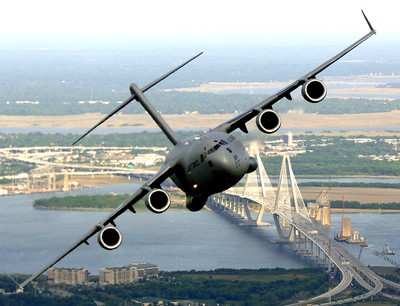Says Current Fleet Of 223, Along With C-5s, Is Sufficient
Airlift Capacity
The military has more than enough large transport planes, and
the appropriation of any more in the next budget year will force
some into premature retirement, Defense Department officials told a
congressional panel Tuesday. "We have enough C-17s," Mike McCord,
principal deputy undersecretary of defense (comptroller), said.
"Money spent on things we don't need takes away from those we do
need."

Along with McCord, Air Force Maj. Gen. Susan Y. Desjardins,
director of strategic plans for Air Mobility Command, and Alan
Estevez, principal deputy assistant secretary of defense for
logistical and materiel readiness, repeated Defense Secretary
Robert M. Gates' position against the purchase of more C-17s to the
Senate Committee on Homeland Security and Government Affairs'
federal financial management subcommittee.
All three defense officials agreed with the subcommittee's
leaders, Sens. Thomas Carper and John McCain, that the C-17, in
addition to the C-5, has been critical to airlift in and out of
Iraq and Afghanistan. However, they said, the military's current
fleet of 223 C-17s and 111 C-5s is more than enough airlift
capability for years to come.

A department study that concluded in February was consistent
with two other studies that found that the current fleet is
sufficient "even in the most demanding environments" to take the
military through 2016, McCord said. The oldest plane in the
transport fleet, Lockheed's C-5A Galaxy, will be viable until 2025,
and the fleet as a whole should last until 2040, he said. The
department has not requested C-17s, built by Boeing, since the
fiscal 2007 budget, yet Congress has added them every year since,
spending about $1.25 billion on C-17s "that we don't want or need,"
said McCord, a 21-year staff member of the Senate Armed Services
Committee before his current appointment. Any additional
appropriation for C-17s will have to be offset by retiring some of
the military's older - but still viable -- transport planes, the
defense officials said.
And, the defense officials said, adding force structure such as
aircraft always entails additional costs in training, maintenance,
and infrastructure, such as new hangars, bases and tooling. The
department spends about $50,000 per aircraft per year to store
aircraft where spare parts are available, Desjardins said. "It's
the gift that keeps on giving, because if you give it to us, we'll
maintain it," Estevez said.
It would be more cost-effective, the defense officials said, to
modify the C-5M for longer viability to continue to work in
conjunction with the C-17.

Desjardins called the C-17 the "backbone" of the air mobility
fleet, and said the C-5's combination of long range, high capacity
and capability to carry outsize cargo is unequaled. Together, she
said, "they meet the needs for cargo and capacity anywhere in the
world."
Retiring the least-capable C-5s would save about $320 million,
Desjardins said. "Making tradeoffs of two types of aircraft when we
already have more than enough of both is not going be cost
effective," McCord said.
Asked what the department would cut to accommodate any new
C-17s, McCord said that would depend on how many new C-17s were
bought. "You and Congress would decide that," he said, "because you
would cut from our budget about $300 million for every C-17
added."

"We have a good mix right now," Estevez said. "Replacement is
definitely not the most cost-effective way. Buying more to retire
more is certainly not the way the department needs to balance its
resources."
The defense secretary has made that case to Congress, and
President Barack Obama has promised to veto any legislation that
provides for more C-17s.
FMI: www.dod.mil
 Airbus Racer Helicopter Demonstrator First Flight Part of Clean Sky 2 Initiative
Airbus Racer Helicopter Demonstrator First Flight Part of Clean Sky 2 Initiative Diamond's Electric DA40 Finds Fans at Dübendorf
Diamond's Electric DA40 Finds Fans at Dübendorf ANN's Daily Aero-Term (04.23.24): Line Up And Wait (LUAW)
ANN's Daily Aero-Term (04.23.24): Line Up And Wait (LUAW) NTSB Final Report: Extra Flugzeugbau GMBH EA300/L
NTSB Final Report: Extra Flugzeugbau GMBH EA300/L Classic Aero-TV: 'Never Give Up' - Advice From Two of FedEx's Female Captains
Classic Aero-TV: 'Never Give Up' - Advice From Two of FedEx's Female Captains






